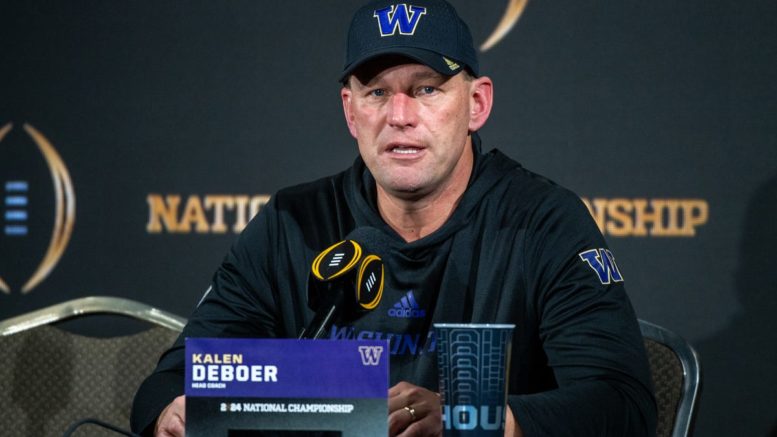In response to Nick Saban’s sudden retirement, the Crimson Tide hired Washington’s Kalen Deboer and averted the mistake that’s plagued program after program over the last half century. Bravo to Alabama for expanding beyond their horizons.
Serving as the CEO of a Fortune 500 football program is one of the most pressure-filled and scrutinized jobs in the multi-billion dollar college athletics industry. At all levels, college athletic departments are afraid to unshackle themselves from unoriginal thoughts like pushing former assistants such as Lana Kiffin to the front of the line. There are dozens of brilliant coaches outside those walls, who have done exemplary jobs at less prestigious programs.
Yet, program after program pursues the alumni of the moment, an assistant coach or former assistant who hangs lowest on the outgoing legend’s coaching tree. History says that athletic departments who use their hearts over their heads when it comes time to appoint a new head football czar fail miserably.
After Bear Bryant stepped down following the 1982 Liberty Bowl, Alabama inexplicably handed the reins to New York Giants coach Ray Perkins over Howard Schnellenberger, architect of The U, Bobby Bowden or Gene Stallings. Perkins had a 40 percent winning percentage as head coach of the Giants and had never been the head of a college program. By 1982, Bowden had won at West Virginia and notched the only three double-digit win seasons at Florida State in his first six seasons. Instead, Bama chose familiarity over competence. Bowden nearly took the job in 1986, but by then Florida State was on the verge of becoming a 1990s powerhouse.
When Woody Hayes was unceremoniously booted from Ohio State, the Buckeyes turned the page to former assistant Earle Bruce. Bruce is one of the few successors to actually stand on his own two feet and was the only coach to leave Iowa State with a winning record before the year 2000. But 81-26 and si-consecutive Iowa State-like seasons couldn’t get the job done.
Florida defensive coordinator Will Muschamp proved to be a subpar head coach at two stops after succeeding Urban Meyer. Aside from an 11-win season in 2012, he couldn’t capture the magic that offensive trendsetters Steve Spurrier or Meyer did.
In 2010, USC tapped an inexperienced and underachieving Kiffin to succeed Pete Carroll at USC. It turns out Kiffin was an unlikable blowhard. Three years later they showed him the courtesy of not ejecting him mid-flight after a loss to Arizona State and sacked him on the tarmac instead.
In January of 2001, Miami’s Butch Davis made his ill-advised leap from Coral Gables to the Cleveland Browns. Larry Coker was handed a promotion, clinched the 2001 natty and under the stewardship of the coach that the most talented locker room full of five-star teenagers clamored for, the program unraveled. Substitute teacher Coker won the national title, should have won another if not for blind officiating, but his tenure was defined by Willie Williams’ celebrity diaries, the 7th Floor Crew making more headlines off the field than on, Nevin Shapiro running amok and an infamous sideline-clearing brawl with FIU.
Quarterback guru Jimbo Fisher actually revived a stagnant Florida State program after Bowden’s resignation, despite having no prior experience as a head coach, but he was a flash in the pan who mostly has Jameis Winston to thank.
From Tom Osborne’s successor Frank Solich to John Robinson standing in John McKay’s shoes or Fred Akers supplanting Darrell Royal at Texas, the formula doesn’t work. The tried formula of choosing comfort over excellence has never worked because it doesn’t jibe with the reality of running a college football program. In college football, inertia is a precursor to fossilization. Offensive geniuses can charge offensive locomotives, but coaches must deal with changing trends, stand sentry over the transfer portal, remain ahead of advancing offensive or defensive schemes and maintain recruiting standards. Offensive savants like Osborne at Nebraska and then-Oklahoma offensive genius Lincoln Riley are the rare exceptions.
Deboer has his own coaching system rather than being an extension of Saban’s. Most programs are too territorial to look outside their inner circle once they reach the level of sustained success Alabama has. Deboer has demonstrated an ability to reinvigorate programs for two decades. Now is his opportunity to join the pantheon. Every four four to five years, the landscape sheds a layer of talent. Imagine a recruiting strategy that limited its evaluations to players from local high schools the coaching staff has an existing rapport with instead of from prep academies.
Alabama’s chances of remaining on top of the college football mountain are thin. Dennis Erickson’s stint at Miami replacing Jimmy Johnson bears the most similarities to Deboer’s, minus the crippling NCAA violations. Erickson was an interloper from Washington State with a proven track record as a program architect. For Erickson then, and Deboer now, the mansion is already built. It just requires proper maintenance. Saban’s name recognition aided in recruiting, and while his successor is starting out with a head start thanks to the reinforced layers of blue chip recruits left behind and a national championship berth that solidified his status as an elite coach at the FBS level, he’ll have to get Alabama back at the pinnacle quickly to defy history.
Follow DJ Dunson on X: @cerebralsportex
Original source here
#Alabama #applauded #defying #historical #trends #hiring #Kalen #Deboer





